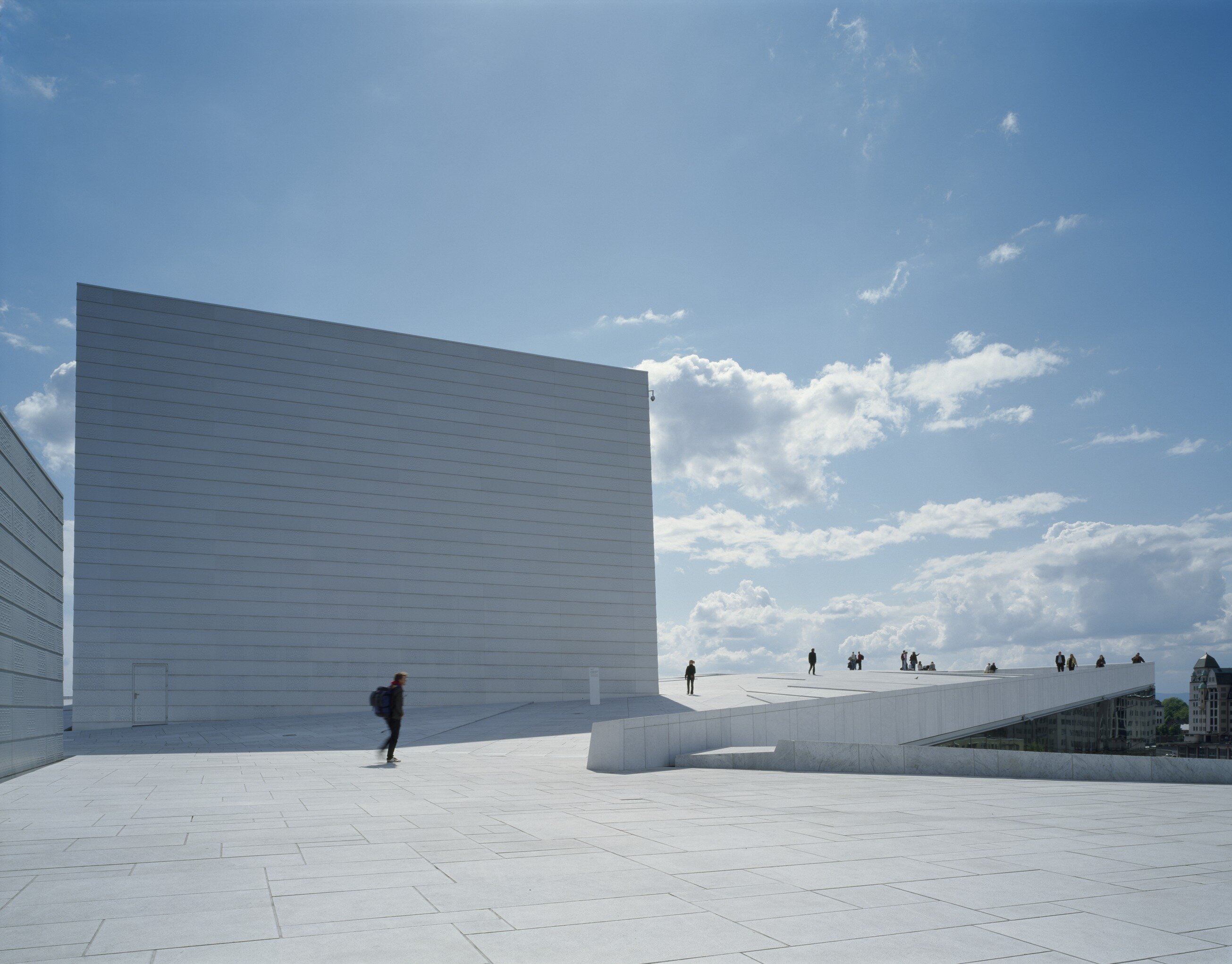Architectural firm Snøhetta is credited with some of the world’s most iconic cultural buildings, from the new SFMOMA expansion and the September 11 Memorial Museum Pavilion, to the modern day incarnation of Alexandria’s fabled library. Not bad for a group of young friends who started out in a small workshop above a dive bar in Oslo, almost 30 years ago now. Guided by a love of nature and an intimate knowledge of the human condition, Snøhetta have taken their simple but radical approach from the peaks of Norway, to the furthest corners of the globe.
On any given day in Oslo, numerous locals and tourists alike hike to the top of the National Opera and Ballet, as if scaling one of the mountains that surround the Norwegian capital. The white marble and glass structure was created by Norwegian architecture and design company, Snøhetta, and resembles a glacier calving into the Oslo harbour, with its roof seemingly emerging out of the water. Since opening in 2008, the opera house has transcended its core function as a cultural institution – going on to become a pivotal public square. In summer, the beach-like western edge attracts swimmers and kayakers, while sunset watchers cluster along the building all year round, while special outdoor performances, like the public screening of ‘Carmen’ in 2009, can prompt crowds of viewers to spread picnic blankets on the roof. During the opera house’s inaugural performance, a young couple were even discovered making love above the auditorium – an act, one of the architects later told the press, he considered equal parts compliment and a proper “consummation” for the new structure.
This year, over 8,000 kilometres to the west of Oslo, an iceberg-like structure opened in San Francisco, instantly becoming another iconic cultural and public space. The SFMOMA extension is also the work of Snøhetta and in a few short months the rippling structure has gained a similarly powerful hold on the cultural imagination – and some friends in high places. The New York Times’ art critic Roberta Smith was so impressed, she wryly pointed out, “The main flaw of the Snøhetta building may be that the San Francisco Modern’s 1995 structure was not demolished to make way for it.”
The Norwegian firm clearly has a knack for getting it right in differing contexts, and its buildings speak to local residents as much as to the international design elite. This is down to Snøhetta’s carefully thought-out, democratic blend of cutting-edge architectural vision and landscape architecture. It is an approach that beautifully, and often surprisingly, integrates nature into even the densest of urban environments.
“We started up Snøhetta in 1987 because we were fed up with landscape architecture being seen as a sort of secondary profession to architecture,” says Kjetil Trædal Thorsen, an architect and the co-founder of Snøhetta, who today runs the Olso office. “Landscape architecture was something you only bothered with if you had any money left over after construction.” A band of like-minded friends, Inge Dahlman, Berit Hartveit, Johan Østengen, Alf Haukeland and Øyvind Mo – along with Thorsen, who was 29 at the time – together came up with the idea for a collaborative architectural and landscape workshop, situated above “one of those old brown bars of Oslo;
a real dive”. The bar was called Dovrehallen, named after Dovre – today Dovrefjell-Sunndalsfjella National Park – a glaciated mountain wilderness, in which the snow-covered Snøhetta is the highest peak. Not wanting to be one of those firms to flaunt the bosses’ initials on the door, Thorsen and his colleagues instead opted for the name Snøhetta that served to underline the enterprise’s strong ties to nature.
As if to demonstrate the full circle of their trajectory, today there is a lone reindeer observation pavilion near that very same Snøhetta mountain. The pavilion could not be further from the firm’s high profile projects scattered around the world. Here, the building’s minimalist square frame of raw steel and glass, protects the organically shaped wooden core. The Norwegian Wild Reindeer Centre Pavilion, set against this stark, isolated landscape, encapsulates the breadth of the firm’s work.
Thinking back to the early days of the company, Thorsen says, “there is a much closer connection between landscape architecture and architecture, than the industry actually seemed to believe back in the 1980s.” He adds, “we decided to put equal importance on both, and take landscape architecture into consideration from the very beginning of the design process.”
 Snohetta Architects Opera House Oslo (2008) Oslo, Norway, 2008
Snohetta Architects Opera House Oslo (2008) Oslo, Norway, 2008
